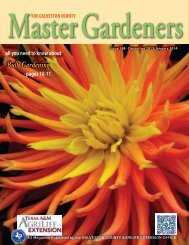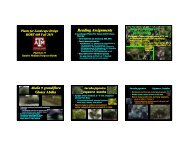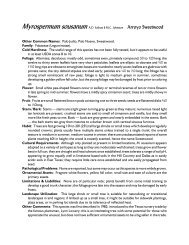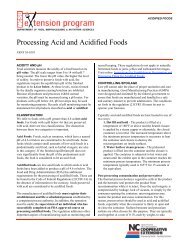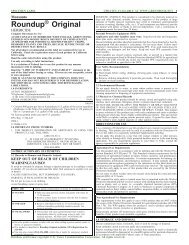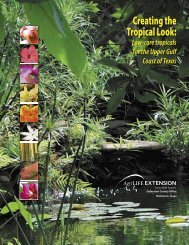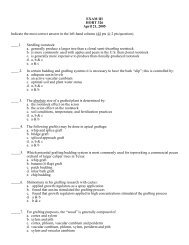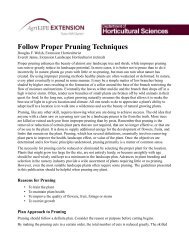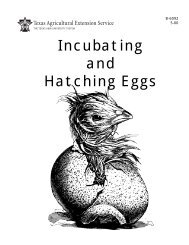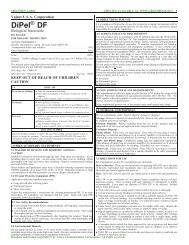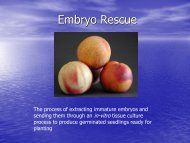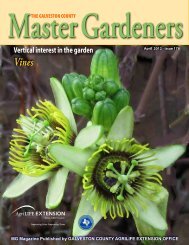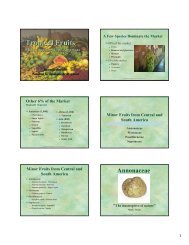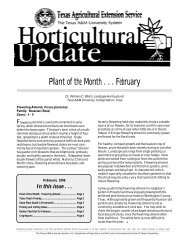Sansevieria Trifasciata - Aggie Horticulture
Sansevieria Trifasciata - Aggie Horticulture
Sansevieria Trifasciata - Aggie Horticulture
Create successful ePaper yourself
Turn your PDF publications into a flip-book with our unique Google optimized e-Paper software.
<strong>Sansevieria</strong> trifasciata Hort. ex D. Prain Snake Plant<br />
(<strong>Sansevieria</strong> laurentii)<br />
Other Common Names: Bowstring Hemp, Devil’s Tongue, Good Luck Plant, Lucky Plant, Mother-<br />
In-Law’s-Tongue, Snake <strong>Sansevieria</strong>.<br />
Family: Agavaceae (placed by some in the Liliaceae).<br />
Cold Hardiness: This subtropical to tropical plant is cold tolerant only in extreme southern portions<br />
of our region, USDA zones 10(9b) to 11.<br />
Foliage: Acaulescent clumps of sessile, stiff, upright, fibrous, plastic-textured succulent, undulating<br />
sword-shaped linear-lanceolate leaves; leaves can reach 3N to 5N in length; typically leaves are green<br />
to gray-green with some extent of mottled, blotched, banded, or vertical striped variegation in<br />
various shades of green, white, or yellow; margins are entire and tips acuminate; glossy; fibrous.<br />
Flower: Although flowering is infrequent, particularly as an interiorscape plant, the fragrant greenish<br />
white to white flowers can be attractive; the perfect individual flowers are narrow, tubular, and eO<br />
to 1cO long and are borne on loose open 10O to 30O long raceme-like leafless scapes; flowers have<br />
six stamen and a superior three-celled ovary, each cell containing a single ovule; when in flower, the<br />
species’ kinship to Agave spp. is most apparent; bloom occurs throughout the year in the tropics, but<br />
is most common in summer in the subtropics.<br />
Fruit: The fruit is botanically an orange to orange-red, globose, ¼O to dO diameter, one to threeseeded<br />
berry; not ornamental; deadhead spend flowers.<br />
Stem / Bark: Stems — leaves originate from small one to six-leaved rosettes on rhizomatous stems;<br />
Buds — buried deep within the rosette of leaves underground; Bark — not applicable.<br />
Habit: Technically S. trifasciata is an evergreen herbaceous perennial, but this 2N to 5N tall plant forms<br />
shrub-like clumps of stiffly upright undulating sword-shaped leaves that more closely resemble a<br />
succulent or cacti than a garden perennial; plants are pleasantly coarse textured.<br />
Cultural Requirements: Snake Plant is a highly versatile species surviving in soils with a wide range<br />
of pH, fertility and textures as long as they are not consistently poorly drained; as with most<br />
succulent-like plants they possess excellent drought tolerance and tolerance to soil and foliar salt<br />
exposure is also high; light exposure can range from full sun to dense shade; plant appearance<br />
benefits from periodic removal of dilapidated leaves; the light-colored variegated forms may bleach<br />
in intense sun.<br />
Pathological Problems: Root / crown rots in wet soils; spider mites, thrips, and various chewing<br />
insects can inflict damage; leaves are long-lived so herbivore damage or foliar vandalism are long<br />
term aesthetic problems.<br />
Ornamental Assets: Snake Plant offers a strong vertical presence, coupled with outstanding<br />
tolerance to drought, low irradiance levels, and soil and foliar salts; variegated forms provide color<br />
for dry dense shade areas.<br />
Limitations & Liabilities: The unusual form of this plant can be difficult to work into conventional<br />
landscapes; limited cold tolerance is the plant’s primary limitation; most cultivars are slow growers;<br />
the plant is reportedly poisonous.<br />
Landscape Utilization: Year-round outdoor use in our region is restricted to areas immediately<br />
adjacent to the Gulf Coast or deep South Texas; outdoors it is typically utilized as an accent,<br />
foundation plant or in mass plantings; dwarf forms will work in subtropical rock gardens; further<br />
north <strong>Sansevieria</strong> spp. are utilized in interiorscapes, patio containers, or roof-top gardens; <strong>Sansevieria</strong><br />
spp. are favorites for coastal landscapes in tropical regions; whole plants, leaves, and flowers are
used for arrangements in the floral industry.<br />
Other Comments: Mother-In-Law’s-Tongue is a virtually indestructible houseplant, making it<br />
perfect for those with brown thumbs; this species is perhaps one of the most widely recognized<br />
plants by nonprofessionals as it inhabits almost every office building and many homes; my bias<br />
coming from a temperate climate is that after observing this species for so long as an interiorscape<br />
plant, it tends to look out of character in most conventional landscapes; the tough fibers in the leaves<br />
are extracted in some tropical countries for use as a fiber crop; the genus is named in honor of an<br />
18 th century Italian prince Raimond de Sangro of Sanseviero; the specific epithet “trifasciata” means<br />
in bundles of three, in reference to the flowers.<br />
Native Habitat: South Africa; it is widely utilized in tropical climates and sometimes escapes<br />
cultivation.<br />
Related Taxa: Several cultivars are more common in the trade than the species type; perhaps the<br />
most widespread is <strong>Sansevieria</strong> trifasciata ‘Laurentii’ (Gold-Banded <strong>Sansevieria</strong> or Gold-Striped<br />
<strong>Sansevieria</strong>) which has wide yellow variegated margins on the leaves; <strong>Sansevieria</strong> trifasciata ‘Hahnii’<br />
(Bird’s Nest <strong>Sansevieria</strong>) is a common 6O to 8O tall dwarf form used in communal potted plant<br />
arrangements and as a small groundcover.<br />
References: Broschat and Meerow, 1999; Dehgan, 1998; Friend, 1942; Gilman and Black, 1999;<br />
Graf, 1992; Kriegel, 1991; Odenwald and Turner, 1996; Rauch and Weissich, 2000; Riffle, 1998;<br />
Watkins and Sheehan, 1975; Whistler, 2000.<br />
Copyrighted 2004 with all rights reserved by Michael A. Arnold; intended for future inclusion in Landscape Plants For<br />
Texas And Environs, Third Edition.



